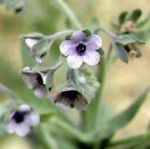| Common Name: |
Rats-and-Mice |
| Other Names: |
Houndstongue |
| Botanical Name: |
Cynoglossum officinale |
| Genus: |
Cynoglossum |
| Family: |
Boraginaceae |
| Native Location: |
C Europe, S and C Russia, C Asia |
| Cultivation: |
Moist, well-drained soil in sun or partial shade. |
| Propagation: |
By seed sown in spring or autumn |
| Harvest: |
Flowering plants and leaves are collected in early summer and dried for use in infusions. Roots are lifted in autumn and dried for use in decoctions. |
| Warning: |
Skin irritant and allergen.
This herb is subject to legal restrictions in some countries. |
| Height: |
80cm-1m (32-36in) |
| Width: |
30-50cm (12-20in) |
| Hardiness: |
Z4-9 |
| Parts Used: |
Whole plant, leaves, roots. |
| Properties: |
A painkilling herb that soothes inflamed tissues and speeds healing. |
| Medicinal Uses: |
Formerly used internally for coughs and diarrhea. Now mostly externally for minor injuries, bites, and leg ulcers, and as a suppository for hemorrhoids. Not prescribed for children or women during lactation. |
| Bibliography: |
Encyclopedia of Herbs by Deni Brown Copyright © 1995, 2001 Dorling Kindersley Limited. Pp 188-189 |

